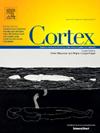Susceptibility to visual hallucinations in the amyotrophic lateral sclerosis-frontotemporal dementia spectrum: The role of dysfunctional attentional networks
IF 3.3
2区 心理学
Q1 BEHAVIORAL SCIENCES
引用次数: 0
Abstract
Psychotic symptoms are well established across the amyotrophic lateral sclerosis-frontotemporal dementia (ALS-FTD) spectrum and contribute to patient and carer distress and poorer prognosis. However, there are no objective tools to probe these symptoms and the underlying functional neurobiology has been unexplored to date. Leveraging clinical interview, neuropsychological testing, and a validated behavioural paradigm of visual misperception combined with connectome-wide fMRI analysis, we directly probed visual hallucinatory tendencies and the associated cognitive and functional connectivity signatures in ALS-FTD. In 82 participants across the ALS-FTD spectrum (24 ALS patients, 7 ALS-FTD, 31 behavioural-variant FTD [19 C9orf72 expansion carriers and 43 non-carriers] and 20 healthy controls), we showed that an ecologically valid behavioural task was sensitive to hallucinatory tendencies. We observed selective involvement of attentional deficits in visual misperception beyond the influence of executive function and psychomotor speed (r ranging from .344-.603; FDR-corrected at p < .05). Following quality control, data-driven whole-brain fMRI analysis in a subset of 26 patients converged to implicate the attentional systems, wherein abnormally heightened connectivity anchored in the attentional, default mode and executive control networks worsened as a function of visual misperception severity (FWE-corrected p = .042 with 10,000 permutations). Our findings underscore the critical role of attentional disruptions, characterised by altered interactions between top-down and bottom-up attentional, introspective, and salience detection processes, in ALS-FTD visual hallucinatory predisposition. Aligning with current models of hallucination generation postulated in schizophrenia, Parkinson's disease, and dementia with Lewy bodies, our findings point towards common neural underpinnings of psychosis vulnerability shared by ALS-FTD.
肌萎缩侧索硬化症-额颞叶痴呆谱系中视觉幻觉的易感性:功能失调的注意网络的作用
在肌萎缩性侧索硬化症-额颞叶痴呆(ALS-FTD)谱系中,精神病性症状得到了很好的确立,并导致患者和护理人员的痛苦和较差的预后。然而,目前还没有客观的工具来探测这些症状,并且潜在的功能神经生物学尚未被探索。利用临床访谈、神经心理学测试和视觉错觉的验证行为范式,结合全连接体fMRI分析,我们直接探讨了ALS-FTD的视觉幻觉倾向以及相关的认知和功能连接特征。在82名ALS-FTD谱系的参与者中(24名ALS患者,7名ALS-FTD, 31名行为变异FTD[19名C9orf72扩展携带者和43名非携带者]和20名健康对照),我们发现生态学上有效的行为任务对幻觉倾向敏感。我们观察到,在视觉误解中,注意缺陷的选择性参与超出了执行功能和精神运动速度的影响(r范围为0.344 - 0.603;fdr校正p <; 0.05)。在质量控制之后,对26名患者进行数据驱动的全脑fMRI分析,结果表明注意力系统受到影响,其中,固定在注意力、默认模式和执行控制网络中的异常增强的连通性随着视觉错觉严重程度的增加而恶化(fwe校正的p = 0.042,有10,000个排列)。我们的研究结果强调了注意力中断在ALS-FTD视幻觉易感性中的关键作用,其特征是自上而下和自下而上的注意力、内省和显著性检测过程之间的相互作用发生了改变。与目前精神分裂症、帕金森病和路易体痴呆的幻觉产生模型一致,我们的发现指出了ALS-FTD共有的精神病易感性的共同神经基础。
本文章由计算机程序翻译,如有差异,请以英文原文为准。
求助全文
约1分钟内获得全文
求助全文
来源期刊

Cortex
医学-行为科学
CiteScore
7.00
自引率
5.60%
发文量
250
审稿时长
74 days
期刊介绍:
CORTEX is an international journal devoted to the study of cognition and of the relationship between the nervous system and mental processes, particularly as these are reflected in the behaviour of patients with acquired brain lesions, normal volunteers, children with typical and atypical development, and in the activation of brain regions and systems as recorded by functional neuroimaging techniques. It was founded in 1964 by Ennio De Renzi.
 求助内容:
求助内容: 应助结果提醒方式:
应助结果提醒方式:


